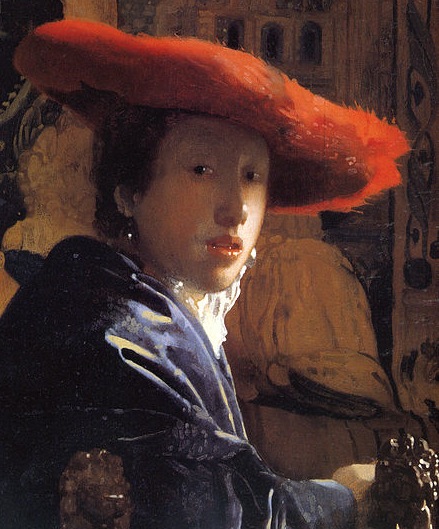Discs of confusion
Professional debunkers, Penn and Teller, have produced a documentary that appears to be an attempt to cash in on “revelations” about Vermeer which have been common assumptions about the painter for at least half a century. NPR reported that there were gasps from the audience when the film was premiered at the Toronto International Film Festival. Apparently, no one in the audience had read much about Vermeer. Vermeer used mechanical tools to aid him in his drawing and painting! That’s a bit like saying, in the voice of Claude Rains, “I”m shocked, shocked, that camera obscura was being employed in Delft!” In all fairness, the film sounds interesting. It apparently follows the inventor Tim Jenison as he uses a small simple device he invented, a lens and mirror that allows him to accurately match what he’s drawing with what he’s seeing. In other words, the conclusion our esteemed comedy team wants us to arrive at is that Vermeer may have been robotically reproducing only what a system of lenses enabled him to see. Busted! It may be a fun film to watch, but what’s being uncovered here isn’t news. For at least half a century, scholars have assumed Vermeer used the equivalent of a photographic projector, a camera obscura, to achieve his remarkable accuracy, and they’ve even noted that the way he handled reflected highlights owes everything to the way a lens creates “discs of confusion,” small discreet orbs that appear when the object is slightly out of focus. Jenison’s mirror/lens device is more or less a new generation of the camera obscura. When Hockney went on his crusade, in the same spirit, about how lens-based Western art has been–the horror!–I yawned as well. Either you use photographic technology or you don’t, and in either case, an artist selectively includes, changes, simplifies, and adjusts what he or she sees, with or without a technological shortcut, in order to create a painting. Photo-realists have been using photographs and projectors for decades. Gerard Richter was happy to demonstrate to visitors how he traced his projected images–before he settled down to the real challenge. Tim Jenison apparently spent seven months reproducing a Vermeer painting for this film. Vermeer may have spent as long, or longer, on each of his rare paintings. And in the process, for each painting, he made a thousand tiny choices on how to simplify or modify what he saw, obsessed with creating a certain kind of scene in a certain quality of light with certain quite specific colors, colors which run throughout his work. His technology didn’t make any of those choices. It served his vision, not the other way around. This brief commentary on the issue from the 60s offers a fine debunking of Penn and Teller’s attempt to debunk Vermeer:
The hypothesis that Vermeer used the camera obscura was recently put to the test by Professor Charles Seymour of the Department of Art History at Yale. He drew parallels between Vermeer’s painting and photography, by demonstrating, for example, how many of the artist’s effects could be reproduced with a camera. In addition, Seymour took a 19th Century viewing camera obscura (no earlier model was available) and set it up about two-and-a-half feet away from a few carefully chosen props–a chair with lion’s head finials, a piece of draped velvet and tapestry backdrop. When these were viewed on the screen of the camera obscura, they exhibited qualities much like those displayed by similar materials in Vermeer’s Girl with a Red Hat. The lion’s head glimmered with discs of confusion, and the fuzzy texture of the velvet was rendered even fuzzier, in all but the middle distance, by the soft focus of uncorrected lenses. Even the quality of light and the color tones mirrored Vermeer’s own. But it was evident, when a photograph was made duplicating these effects in a polished metal mirror, that an all-important ingredient was missing–the artist’s selective eye. The secret of Vermeer’s art is not that he used the camera obscura, but that he used it so well–as a point of departure for art, never as an end in itself. –Hans Koningsberger
The photograph these researchers took of the staged duplication of Vermeer’s setting looks flat and lifeless. The painting itself is quite the opposite.

I’m right there with you on this. Give anybody a projector or a camera obscura or a magic wand and they aren’t going to make a Vermeer or a Richter.
The only thing I can think is that the making of beautiful art is such a mystery to most people that they subconsciously think there isn’t a human being behind it.
Debunked: The Myth That Gods Come To Earth To Paint
— and it seems like I read somewhere that Penn or Teller is an evangelical Atheist so maybe they’re educating us not to believe in art fairies.
Totally agree Sarah. Yeah, they have a show that’s been on for years where they “debunk” everything and anything. It’s a bit of a disease. Yes, aggressive atheists are as off-putting as the fanatically faithful. The hubris behind most certainty about anything is what makes it hard to stomach. A lot of certainty out there these days . . .